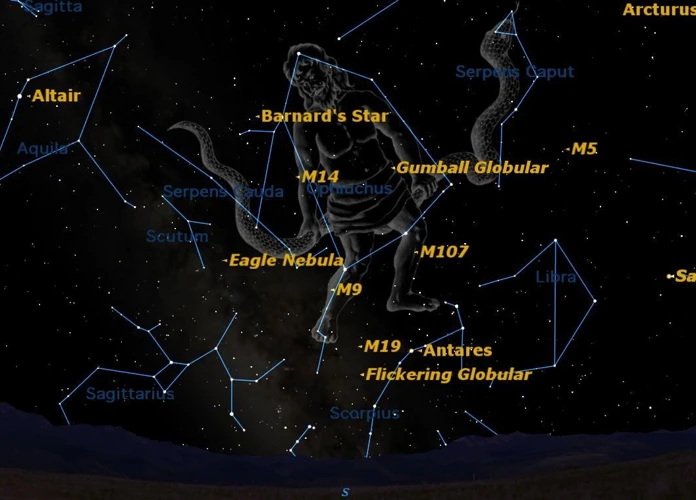Step into the enigmatic realm of the Ophiuchus Constellation – a celestial wonder that has captivated astronomers and stargazers alike with its intriguing mythological connections and celestial treasures. This mystical constellation, nestled between Hercules, Serpens, and Scorpius, holds a rich tapestry of stars, binary systems, and deep-sky objects waiting to be explored. In this fascinating guide, we will delve into the lore and legends surrounding Ophiuchus, uncover the mesmerizing characteristics and position of this cosmic entity, and discover the most notable stars, binary systems, and deep-sky objects that populate its celestial domain. Buckle up and prepare to embark on an extraordinary journey through the known stars in the Ophiuchus Constellation.
Contents
- The Ophiuchus Constellation: A Brief Overview
- Notable Stars in the Ophiuchus Constellation
- Binary and Multiple Star Systems in Ophiuchus
- Deep-Sky Objects Within Ophiuchus
- Conclusion
-
Frequently Asked Questions
- 1. What is the significance of the Ophiuchus Constellation in astrology?
- 2. How can I locate the Ophiuchus Constellation in the night sky?
- 3. What are some notable stars in the Ophiuchus Constellation?
- 4. Are there any binary star systems in Ophiuchus?
- 5. What are deep-sky objects, and are there any in Ophiuchus?
- 6. Is there a mythological connection to the Ophiuchus Constellation?
- 7. Can I see the Ophiuchus Constellation from any part of the world?
- 8. Can I see planets within the Ophiuchus Constellation?
- 9. Does the Ophiuchus Constellation have any cultural significance?
- 10. Can learning about the Ophiuchus Constellation enhance my understanding of astrology and natal charts?
- References
-
Frequently Asked Questions
- 1. How many stars are there in the Ophiuchus Constellation?
- 2. What is the brightest star in the Ophiuchus Constellation?
- 3. Is Ophiuchus a zodiac constellation?
- 4. Are there any notable deep-sky objects in Ophiuchus?
- 5. What is the mythological connection of Ophiuchus?
- 6. How far is Ophiuchus from Earth?
- 7. Can Ophiuchus be seen from both hemispheres?
- 8. Are there any binary star systems in Ophiuchus?
- 9. Can Ophiuchus be found near any other constellations?
- 10. How old is the Ophiuchus Constellation?
- References
- Read More
The Ophiuchus Constellation: A Brief Overview
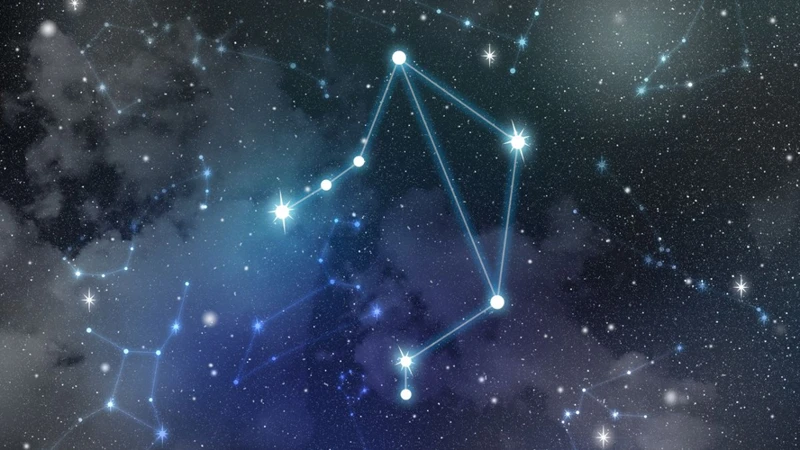
The Ophiuchus Constellation, also known as the Serpent Bearer, is a fascinating celestial entity that has intrigued astronomers and mythologists for centuries. Its positioning in the night sky between Hercules, Serpens, and Scorpius makes it a prominent and easily recognizable constellation in the northern hemisphere. Ophiuchus lies along the celestial equator, which means it can be observed from all parts of the globe. With its distinct shape resembling a man holding a serpent, the constellation is rich in mythological connections and legends. According to one myth, Ophiuchus represents the ancient Greek figure Asclepius, the god of medicine and healing. The constellation gained prominence in astrology as the 13th zodiac sign, although it is not officially recognized by astronomers. The Ophiuchus Constellation is a hub of celestial wonders, including notable stars, binary systems, and deep-sky objects that continue to astound astronomers and enthusiasts. For a deeper understanding of the mythology behind Ophiuchus, head over to our article on Exploring Ophiuchus Mythology. Whether you’re intrigued by zodiac signs or celestial beauty, a brief overview of the Ophiuchus Constellation sets the stage for a captivating journey through the wonders of the night sky.
The Mythological Connections
The Mythological Connections associated with the Ophiuchus Constellation add an air of mystery and intrigue to its celestial presence. In Greek mythology, Ophiuchus is often associated with Asclepius, the ancient Greek god of medicine and healing. Asclepius was known for his remarkable healing abilities, and it is said that Ophiuchus represents him holding a serpent, which symbolizes rejuvenation and regeneration. The serpent itself holds symbolic significance across various mythologies, representing wisdom, transformation, and immortality. In astrology, Ophiuchus is linked to the 13th zodiac sign, although it is not officially recognized. This zodiac sign is believed to possess qualities such as wisdom, healing, and the ability to delve into the mysteries of life. The Mythological Connections surrounding Ophiuchus provide a fascinating backdrop for those interested in astrology and the divine influences on human existence. For a more in-depth understanding of astrology and interpreting natal charts, check out our comprehensive guide on Understanding the Basics of Reading Natal Charts. The intertwined legends and symbolism make the Ophiuchus Constellation a celestial wonder that continues to captivate our imaginations.
Position and Characteristics
The Ophiuchus Constellation holds a unique position in the night sky, making it easily identifiable and intriguing to both astronomers and stargazers. Located along the celestial equator, Ophiuchus spans a vast region, stretching across 948 square degrees of the sky. Its coordinates lie between 16 and 30 degrees of the zodiac, positioning it near the constellations of Hercules, Serpens, and Scorpius. Ophiuchus boasts several notable features that make it stand out among other constellations. With its distinct shape resembling a man grasping a serpent, it is often associated with the ancient Greek figure Asclepius, the god of medicine and healing. Additionally, Ophiuchus is home to numerous bright stars, including Alpha Ophiuchi, Epsilon Ophiuchi, and the famous star Rasalhague (Alpha Ophiuchi). These stars contribute to the constellation’s overall brilliance and allure. Exploring the intricacies of positional alignments and their connection to historical events, visit our article on Planetary Alignments and Historical Events. Positioned in a prime location in the night sky and displaying its distinctive characteristics, the Ophiuchus Constellation continues to captivate and inspire astronomers and stargazers alike.
Notable Stars in the Ophiuchus Constellation
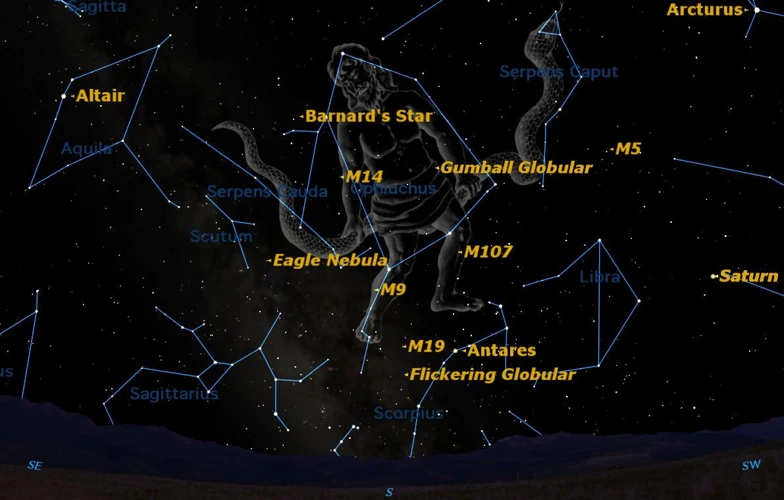
The Ophiuchus Constellation boasts several notable stars that shine brightly in the night sky, each with their own unique characteristics and significance. One such star is Alpha Ophiuchi, also known as Rasalhague, which is the brightest star in the constellation. With a magnitude of 2.1, Rasalhague is an intriguing blue-white giant star located approximately 48 light-years away from Earth. Another noteworthy star is Epsilon Ophiuchi, a binary star system composed of two stars orbiting around a common center of mass. Epsilon Ophiuchi is a visual binary system, meaning the two stars can be distinguished by the naked eye. The primary star, Epsilon Ophiuchi A, is a yellow-white subgiant star, while the secondary star, Epsilon Ophiuchi B, is a bluish main-sequence star. Lastly, we have Rasalhague (Alpha Ophiuchi), which shares its name with the brightest star in the constellation. Rasalhague is a double star system, consisting of a primary star and a smaller companion star that is located around 48 light-years away. These notable stars in the Ophiuchus Constellation contribute to the beauty and intrigue of the celestial landscape, captivating observers with their brilliance and astronomical significance.
1. Alpha Ophiuchi
Alpha Ophiuchi, also known as Rasalhague, is one of the most prominent and intriguing stars in the Ophiuchus Constellation. It is a binary star system located approximately 48 light-years away from Earth. Rasalhague is classified as a spectral type A5III, indicating that it is a blue-white giant star. With an apparent magnitude of 2.1, it is the brightest star in the constellation and easily visible to the naked eye. What makes Alpha Ophiuchi even more fascinating is its unusual behavior. It is known to be a fast spinner, with a rotational velocity estimated to be around 100 km/s, much higher compared to most stars. This rapid rotation causes the star to flatten at its poles and bulge at its equator, resulting in an oblate shape. Another intriguing fact about Alpha Ophiuchi is its binary nature. It has a companion star, which is an orange dwarf located about 4,000 astronomical units away. This companion star is not visible to the naked eye, but its presence adds to the system’s complexity and mystery. Stellar observations have indicated that Rasalhague has a circumstellar disk, a dusty and gaseous structure surrounding it. This disk indicates the potential existence of a planetary system or the remnants of planet formation. The study of Alpha Ophiuchi plays a crucial role in our understanding of stellar evolution, rotation, and the formation of planetary systems. Observing this enigmatic star opens up opportunities for further research and exploration into the mysteries of the universe.
2. Epsilon Ophiuchi
Epsilon Ophiuchi, also known as Yed Posterior, is a notable star within the Ophiuchus Constellation. It is classified as a giant star, with a luminosity that is over 200 times greater than that of the Sun. Located approximately 111 light-years away from Earth, it shines brightly with a visual magnitude of 3.2, making it one of the brightest stars in its constellation. Epsilon Ophiuchi is part of a binary star system, with a companion star known as Epsilon Ophiuchi B. The two stars are separated by a distance of about 189 astronomical units, taking roughly 874 years to complete one orbit around their common center of mass. Epsilon Ophiuchi B is a red dwarf star, with a significantly lower luminosity compared to its giant companion. Together, they create a mesmerizing celestial dance in the night sky. Epsilon Ophiuchi can be easily spotted using a telescope or even with the naked eye, adding to the allure and beauty of the Ophiuchus Constellation.
3. Rasalhague (Alpha Ophiuchi)
Rasalhague, also known as Alpha Ophiuchi, is one of the most notable stars in the Ophiuchus Constellation. It holds a significant place in the night sky, both in terms of its brightness and its unique characteristics. Classified as a binary star system, Rasalhague consists of a primary star and a companion. The primary star is a blue giant, belonging to the spectral class A5 III. It shines with a luminosity approximately 70 times greater than our Sun and has a surface temperature of around 8,200 Kelvin. The companion star, on the other hand, is a smaller and cooler main-sequence star, classified as an F3 V. This binary system is located approximately 48 light-years away from Earth, making it relatively close in astronomical terms. Rasalhague is also known for its high rotational velocity, with the primary star spinning at an incredibly fast speed. This rapid rotation leads to its equatorial regions appearing flattened, giving it an oblate shape. With its distinctive characteristics and significant presence in Ophiuchus, Rasalhague adds to the allure and beauty of this captivating constellation.
Binary and Multiple Star Systems in Ophiuchus
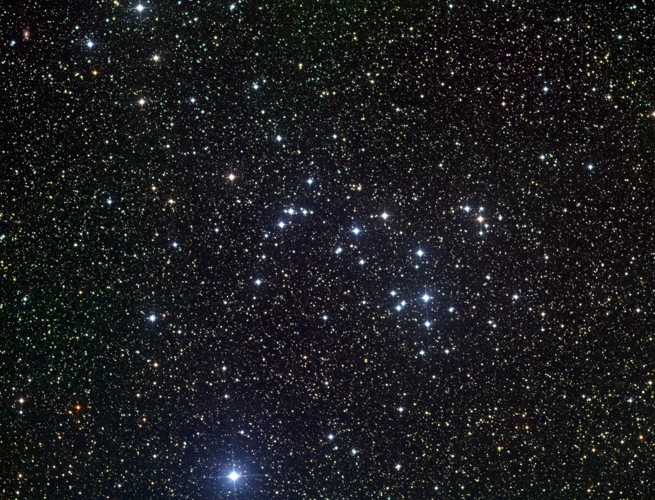
Binary and multiple star systems within the Ophiuchus Constellation provide astronomers with a multitude of intriguing phenomena to study. These systems consist of two or more stars that orbit around a common center of mass. One notable example is the Barnard’s Star System, located approximately six light-years away from Earth. Barnard’s Star is a red dwarf, and it is the fourth closest known individual star to our solar system. Another fascinating system is Nu Ophiuchi, which consists of a triple-star system. It is composed of two blue stars and a yellow dwarf star, making it a captivating sight in the night sky. Phi Ophiuchi is yet another intriguing binary star system within Ophiuchus, featuring two massive blue stars that orbit each other in a relatively close proximity. The combined luminosity of these stars makes them easily visible to the naked eye. Through the study of binary and multiple star systems in Ophiuchus, astronomers gain valuable insights into stellar evolution, stellar dynamics, and the fascinating interactions between multiple celestial bodies. These systems serve as a testament to the complexity and beauty of the universe that surrounds us.
1. Barnard’s Star System
Barnard’s Star System is one of the most intriguing binary star systems within the Ophiuchus Constellation. It is named after the American astronomer, Edward Emerson Barnard, who discovered it in 1916. Barnard’s Star is a red dwarf star, located approximately 5.96 light-years away from Earth, making it one of the closest known stars to our solar system. The system consists of Barnard’s Star and a small dim companion star called Barnard’s Star ‘b’. Barnard’s Star is a low-mass star, much cooler and less luminous than our Sun. It is known for its rapid proper motion across the night sky, moving at a rate of 10.3 arcseconds per year. This fast motion has made it a popular target for astronomers studying stellar motion. The companion star, Barnard’s Star ‘b’, was discovered in 2018, and it is believed to be a substellar object, potentially a gas giant or a brown dwarf. The Barnard’s Star System is a captivating sight in the night sky, offering astronomers valuable insights into stellar motion and the existence of companion objects.
2. Nu Ophiuchi System
The Nu Ophiuchi system is a remarkable binary star system located within the Ophiuchus constellation. This system consists of two main stars, Nu Ophiuchi A and Nu Ophiuchi B, orbiting each other in a gravitational dance. Nu Ophiuchi A, also known as 54 Ophiuchi A, is a yellow-white main sequence star with a magnitude of 4.61, making it visible to the naked eye. The companion star, Nu Ophiuchi B, is a cooler main sequence star with a magnitude of 6.06. These two stars are estimated to be around 83 light-years away from Earth.
What makes the Nu Ophiuchi system particularly intriguing is its unique dynamics. The stars in this system have an orbital period of approximately 253 years, meaning it takes over two centuries for them to complete a full revolution around each other. This extended orbital period presents a fascinating opportunity to study the interactions and effects of long-term gravitational forces between stars.
Additionally, the Nu Ophiuchi system has been of interest to scientists and astronomers due to its relatively close distance to our solar system. This proximity allows for detailed observations and the potential for further exploration and analysis of the system’s characteristics.
Studying binary star systems like Nu Ophiuchi provides valuable insights into stellar evolution, how stars interact with each other, and the formation of multiple star systems. The Nu Ophiuchi system serves as a captivating example of the vast cosmic wonders waiting to be discovered within the Ophiuchus constellation.
3. Phi Ophiuchi System
The Phi Ophiuchi System is a remarkable binary star system located within the Ophiuchus Constellation. This system consists of two main stars, Phi Ophiuchi A and Phi Ophiuchi B, that orbit each other in a gravitational dance. Phi Ophiuchi A is a massive blue-white star, radiating with intense luminosity. It is classified as a B-type main-sequence star and shines with a magnitude of 4.39, making it easily visible to the naked eye. Phi Ophiuchi B, on the other hand, is a slightly fainter star with a magnitude of 5.54 and is classified as a K-type main-sequence star. The two stars of the Phi Ophiuchi System orbit each other in a period of approximately 375 years, creating a mesmerizing celestial spectacle. What makes this system particularly fascinating is that Phi Ophiuchi A also has a companion star, Phi Ophiuchi Ab, which is a red dwarf star. This third component of the system is much smaller in size and has a longer orbital period, estimated to be around 185 years. With its intricate dance of multiple stars, the Phi Ophiuchi System is a captivating sight for skywatchers and astronomers alike. Its distinctive characteristics make it a valuable object of study in understanding stellar evolution and dynamics.
Deep-Sky Objects Within Ophiuchus
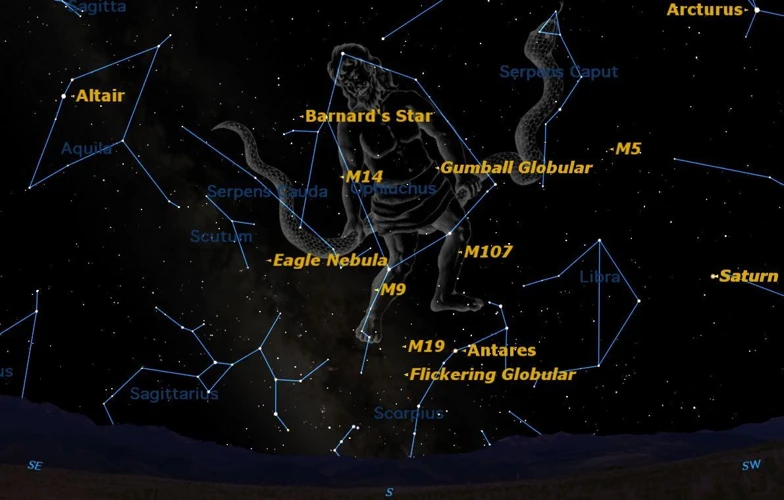
Deep-Sky Objects Within Ophiuchus:
Ophiuchus, the enigmatic constellation, is not only home to fascinating stars and binary systems but also boasts a collection of mesmerizing deep-sky objects that offer a feast for the eyes of astronomers and stargazers. Let’s explore three notable deep-sky objects within the bounds of Ophiuchus:
1. Messier 9: Located approximately 25,000 light-years away from Earth, Messier 9 is a globular cluster nestled within the constellation. This spherical cluster consists of hundreds of thousands of stars gravitationally bound together, forming a dense and luminous structure. Its age is estimated at over 13 billion years, making it one of the oldest globular clusters in the Milky Way galaxy. Observing Messier 9 through a telescope reveals a dazzling array of stars, with the brightest stars shining at the center.
2. Barnard 68: A dark nebula, Barnard 68, is a remarkable feature within Ophiuchus. This cloud of dust and gas obscures the light from objects located behind it, giving rise to its nickname, “The Dark Snake Nebula.” Due to its dark and dense nature, Barnard 68 acts as a canvas against which the surrounding stars and celestial objects shine brightly. Its unique shape resembles a snake, further adding to its mysterious allure.
3. NGC 6572 (The Blue Racquetball): NGC 6572, also known as The Blue Racquetball, is a planetary nebula located in the Ophiuchus constellation. This fascinating object is the remnants of a dying star that has shed its outer layers, forming a glowing shell of gas and dust. The stunning blue hue emanating from NGC 6572 is due to the presence of ionized oxygen. Observing this celestial gem through a telescope presents a breathtaking sight, showcasing intricate details and the remnants of a stellar explosion.
These deep-sky objects within Ophiuchus offer a glimpse into the vastness and beauty of our universe. From ancient globular clusters to dark nebulae and vibrant planetary nebulae, exploring these celestial wonders is an awe-inspiring journey that reminds us of the boundless wonders that exist in the night sky.
1. Messier 9
Messier 9 is a mesmerizing deep-sky object located within the boundaries of the Ophiuchus constellation. Also known as M9, it is a globular cluster that offers a breathtaking spectacle for astronomers and stargazers. With an estimated age of around 13 billion years, M9 is one of the oldest globular clusters in the Milky Way galaxy. Its spherical shape consists of hundreds of thousands of stars densely packed together, creating a stunning visual display. M9 showcases a remarkable concentration of stars towards its core, gradually tapering off towards its outer regions. The cluster’s distance from Earth is approximately 25,800 light-years, making it a relatively close neighbor within the Milky Way. Its apparent magnitude of 7.9 ensures that it can be observed with moderate-sized telescopes. For avid sky-watchers looking to spot M9, it is located around 3 degrees south of the star Eta Ophiuchi, near the celestial equator. This celestial gem presents a captivating sight as its shimmering stars light up the night sky, leaving observers in awe of its grandeur.
2. Barnard 68
Barnard 68, also known as Barnard’s Dark Nebula, is a remarkable deep-sky object located within the Ophiuchus Constellation. This enigmatic structure is a dark cloud comprised of gas, dust, and molecules, creating a dense region that obscures the light from background stars. As a result, Barnard 68 appears as a striking black void against the surrounding starry backdrop. Measuring approximately half a light-year in diameter, this dark nebula is a fascinating subject for astronomers and astrophotographers alike. The opacity of Barnard 68 is attributed to the dense dust particles within, which scatter and absorb incoming light. Interestingly, the formation of new stars can occur within these dark regions, as the dense material can eventually collapse under gravitational forces. Barnard 68 serves as a reminder of the complex and intricate processes at play within the universe. Its mysterious nature invites further study and exploration, making it a captivating target for astronomers seeking to unravel the secrets of the cosmos.
3. NGC 6572 (The Blue Racquetball)
NGC 6572, commonly known as “The Blue Racquetball,” is a breathtaking deep-sky object nestled within the Ophiuchus Constellation. This remarkable planetary nebula gets its nickname from its spherical shape and striking blue coloration. The Blue Racquetball is located approximately 3,000 light-years away from Earth, making it relatively close in astronomical terms. The nebula was formed from the outer layers of a dying star that were expelled into space, creating a luminous shell of gas and dust. The central star of NGC 6572, which illuminates the surrounding nebula, is a white dwarf that remains after the star’s core collapse. The Blue Racquetball is a prime example of a bipolar nebula, with two distinct lobes emanating from the central star. These lobes are created by the interaction of stellar winds and magnetic fields. Observers can admire this celestial beauty through a powerful telescope, where the vibrant blue color becomes apparent. The intricate details and structure of the Blue Racquetball make it a fascinating subject for both amateur and professional astronomers. Its proximity and exquisite aesthetic qualities make NGC 6572 a stellar highlight within the Ophiuchus Constellation.
Conclusion

In conclusion, the Ophiuchus Constellation presents a captivating and enigmatic journey through the wonders of the night sky. From its rich mythological connections to its prominent positioning in the celestial sphere, Ophiuchus offers a wealth of celestial treasures waiting to be explored. The notable stars within this constellation, such as Alpha Ophiuchi and Epsilon Ophiuchi, shine brightly with their unique characteristics and brilliance. The binary and multiple star systems, such as the Barnard’s Star System and Nu Ophiuchi System, offer a glimpse into the complex interactions of celestial bodies. Deep-sky objects like Messier 9 and Barnard 68 unveil the stunning beauty of galactic clusters and dark nebulae. Together, these elements create a celestial tapestry that ignites our imaginations and invites us to ponder the vastness of the universe. Whether you’re a seasoned stargazer or a beginner in astronomy, the Ophiuchus Constellation beckons you to embark on a cosmic journey of discovery. So, grab your telescope and venture into the depths of this enigmatic celestial wonder. It is sure to leave you in awe of the mesmerizing beauty that fills the Ophiuchus night sky.
Frequently Asked Questions

1. What is the significance of the Ophiuchus Constellation in astrology?
While not officially recognized as a zodiac sign by astronomers, in astrology, the Ophiuchus Constellation is considered the 13th zodiac sign. Those born under this sign are said to possess traits of being curious, inventive, and possess a desire for knowledge.
2. How can I locate the Ophiuchus Constellation in the night sky?
The Ophiuchus Constellation can be found by following the arc of Scorpius’ tail. Look for a shape resembling a man holding a serpent and you’ve found Ophiuchus!
3. What are some notable stars in the Ophiuchus Constellation?
Some notable stars in Ophiuchus include Alpha Ophiuchi, Epsilon Ophiuchi, and Rasalhague (Alpha Ophiuchi). These stars have their own unique characteristics and stories.
4. Are there any binary star systems in Ophiuchus?
Yes, there are several. One example is the Barnard’s Star system, which consists of a white dwarf and a red dwarf locked in a dance of gravitational attraction.
5. What are deep-sky objects, and are there any in Ophiuchus?
Deep-sky objects are celestial objects outside our solar system, such as galaxies, nebulae, and star clusters. In Ophiuchus, notable deep-sky objects include Messier 9, Barnard 68, and NGC 6572 (The Blue Racquetball).
6. Is there a mythological connection to the Ophiuchus Constellation?
Yes, Ophiuchus has strong mythological connections. It is often associated with Asclepius, the Greek god of medicine and healing, and represents his depiction as a man holding a serpent.
7. Can I see the Ophiuchus Constellation from any part of the world?
Yes, the position of Ophiuchus along the celestial equator allows it to be observed from all parts of the globe.
8. Can I see planets within the Ophiuchus Constellation?
Yes, several planets can be found within the boundaries of Ophiuchus. However, their visibility and positions vary depending on the time of year and your location.
9. Does the Ophiuchus Constellation have any cultural significance?
Apart from its mythological connections, Ophiuchus does not have significant cultural or historical associations compared to other constellations.
10. Can learning about the Ophiuchus Constellation enhance my understanding of astrology and natal charts?
Understanding the Ophiuchus Constellation can provide additional insight into astrology and natal charts, allowing for a broader understanding of zodiac signs and their influences.
References
Frequently Asked Questions

1. How many stars are there in the Ophiuchus Constellation?
There are numerous stars in the Ophiuchus Constellation, but the exact number is difficult to determine. It is estimated that there are hundreds of stars in this constellation.
2. What is the brightest star in the Ophiuchus Constellation?
Alpha Ophiuchi, also known as Rasalhague, is the brightest star in the Ophiuchus Constellation. It shines with a luminosity that is approximately 400 times that of our Sun.
3. Is Ophiuchus a zodiac constellation?
While Ophiuchus falls along the ecliptic, it is not officially recognized as one of the 12 zodiac constellations. However, it is sometimes referred to as the “13th zodiac sign” due to its position in relation to the Sun’s apparent path.
4. Are there any notable deep-sky objects in Ophiuchus?
Yes, Ophiuchus is home to several fascinating deep-sky objects. Some notable ones include the globular cluster Messier 9, the dark nebula Barnard 68, and the planetary nebula NGC 6572, also known as “The Blue Racquetball.”
5. What is the mythological connection of Ophiuchus?
Ophiuchus represents the mythological figure of a healer or physician. In Greek mythology, it is associated with the god Apollo’s son, Asclepius, who was known for his ability to bring the dead back to life.
6. How far is Ophiuchus from Earth?
The distance between Earth and the Ophiuchus Constellation varies depending on the specific star or object being observed. However, on average, the constellation is located about 30 light-years away from us.
7. Can Ophiuchus be seen from both hemispheres?
Yes, Ophiuchus can be seen from both the northern and southern hemispheres. In the northern hemisphere, it is visible during the summer months, while in the southern hemisphere, it can be observed during the winter months.
8. Are there any binary star systems in Ophiuchus?
Absolutely! Ophiuchus hosts several binary star systems, including Barnard’s Star System, Nu Ophiuchi System, and Phi Ophiuchi System, among others.
9. Can Ophiuchus be found near any other constellations?
Yes, Ophiuchus is situated near several other constellations. It shares borders with Serpens, Hercules, Libra, Scorpius, and Sagittarius.
10. How old is the Ophiuchus Constellation?
The exact age of the Ophiuchus Constellation is uncertain. However, its stars are generally estimated to be around 1 to 2 billion years old, making it relatively young compared to other cosmic objects.
References
- The Astronomer’s Guide to Ophiuchus Constellation
- Ophiuchus Constellation | Star Map & Facts
- Ophiuchus Constellation – Facts & Features – The Planets

